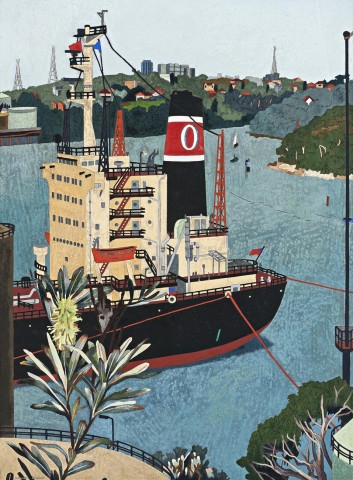THE EBRO, GORE BAY, 1987
CRESSIDA CAMPBELL
watercolour on incised woodblock
80.0 x 60.0 cm
signed lower left: Cressida Campbell
Nevill Keating Pictures, London
Private collection, Sydney
Cressida Campbell: recent paintings, Nevill Keating Pictures, London, 6 – 27 July 2001, cat. 29 (illus. in exhibition catalogue, unpaginated)
Destination Sydney, S.H. Ervin Gallery, Sydney, 10 December 2015 – 21 February 2016
Crayford, P., (ed.), The Woodblock Painting of Cressida Campbell, Public Pictures, Sydney, 2008, cat. W8705, pp. 96 (illus.), 97 (illus.), 98, 99 (illus.), 348 (as ‘The Ebro’)
Pearson, C., ‘Block Star on a Quiet Roll’, The Australian, Sydney, 1 November 2008
Klepac, L., Destination Sydney, exhibition catalogue, Manly Art Gallery & Museum, Mosman Art Gallery, S. H. Ervin Gallery, Sydney, 2015, pp. 110 (illus.), 120 (as ‘The Ebro’)
There are few artists whose successes transcend state and national borders, even fewer who do it with art that is both original and profoundly imbued with a sense of place. Cressida Campbell is one such artist. Her unique prints and woodblocks have a casual reverence to them, one that exudes serenity regardless of its subject matter. While Campbell’s works have long been appreciated for their subtle decorative quality, it must be noted that in terms of subject matter, the artist does not shy away from depicting unexpected views, slices of contemporary reality.
In The Ebro, Gore Bay, 1987 Campbell whittles into the panel of marine plywood the steel railings, cogs and smoke stacks – images of the industrial bedrock upon which this harbour town has been built. Campbell has diverted her gaze towards the west of the cove, away from the landmark of civic pride for Sydney-siders, the Harbour Bridge, to depict instead the reverse of the coin, a tranquil view of its operating industrial port. Appreciating the unusual composition and unsung view of the harbour, The Ebro, Gore Bay was included in the landmark exhibition on Sydney Harbour, Destination Sydney, at the S.H. Ervin Gallery in 2015, with John McDonald writing ‘the harbour is only glimpsed amidst the crowded rows of terrace houses, warehouses, silos, dockyards and clumps of trees […] we are not looking at a quasi-photographic record of the view, but a creative re-imagining, devoid of deep space’.1
The Ebro, Gore Bay, is a key early woodblock depicting a composite view of an urban skyline, an industrial landscape, a panorama dotted with ships, and a cheeky botanical study bisecting the foreground. This amalgamation of artistic subjects and genres became the format of many of Campbell’s early harbour masterpieces, including Gore Bay, 1992, Parsley Bay, 1992, and the magnificent triptych West of Observatory Hill, 1989. The industrial cove of Gore Bay, used by Shell Transport and Trading Company since 1901, and the dense native bush found opposite on Berry Island Reserve, was the subject of a number of artworks of particular significance in the swift progression of Campbell’s successful career as a printmaker in Sydney, from the ACTA Maritime Art Award winning Gore Bay, 1990, to the Wynne Watercolour Prize winning Berry’s Bay, 1992. The westward view from Gother Avenue Walkway on Mann’s Point in Greenwich, over the oil tanks, is similar to the one featured in Through the Windscreen, 1987, an early print that is held in the collections of both the Art Gallery of New South Wales, Sydney and the National Gallery of Australia, Canberra. In an interview in 1990, Campbell explained the allure of this section of the harbour in her work, evoking the ‘serenity of the bay, with its ominous tanks both exciting and beautiful’.2
Although many of her later images of Gore Bay have a deliberately muted tonal palette, the serenity of which contrasts with the functionality of the harbour, this woodblock has the bold tones and contrasts of Campbell’s earlier work. The two prints produced from this block were exhibited in Mori Gallery in 1987 and despite the artist having already exhibited woodblocks as early as 1985, this particular example stayed in the artist’s own collection for fifteen years before being exhibited in London at Nevill Keating Pictures in 2001. Despite this relative early anonymity, this image in its printed form was chosen to grace the cover of the cultural and literary periodical The Sydney Review, in June 1988. The editors of the magazine later reflected that this work is a ‘[…] marvellous image of Sydney as a working port […] While the harbour’s beauty and potential vulnerability are there for all to see, viewers are left to draw their own conclusions. The artist has captured the extraordinary within the everyday’.3
1. McDonald, J., ‘Cressida Campbell’ in Klepac, L. (ed), Destination Sydney, Manly Art Gallery & Museum, Mosman Art Gallery, S.H.Ervin Gallery, Sydney, 2015, p. 108
2. ‘Art Award’, Sydney Morning Herald, Sydney, 15 June 1990, p. 4
3. Pearson C., ‘Block star on a quiet roll’, The Australian, 1 November 2008
LUCIE REEVES-SMITH
